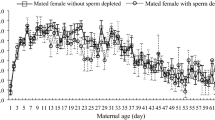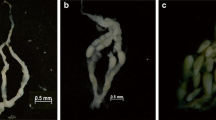Summary
The parasitic wasp Nesolynx albiclavus maintains a very skewed offspring sex ratio (ca. 4% males). We studied proximate, causal factors of the son-daughter choice mechanism to obtain insight into the precision of the procedures and the underlying rules. We analyzed the number of males in clutches produced during sessions of 12 or 24 h. The results show that the timing of the next male egg depends on the time elapsed and the number of eggs laid since the previous one. The influence of the passage of time per se during non-laying periods was reduced in an experiment with 4-h periods. The data show that the first male egg is produced by a fairly rigid process: about the sixth egg in a run will be left unfertilized. No further male egg will appear in the next 10–20 eggs if they are laid in rapid succession.
Similar content being viewed by others
References
Alphen JJM van, Thunissen I (1983) Host selection and sex allocation by Pachycrepoideus vindemiae as a facultative parasitoid of Asobara tabida and Leptopilina heterotoma. Neth J Zool 32:497–514
Assem J van den (1971) Some experiments on sex ratio and sex regulation in the pteromalid Lariophagus distinguendus. Neth J Zool 21:373–402
Assem J van den, Gijswijt MJ, Nübel BK (1980) Observations on courtship- and mating strategies in a few species of parasitic wasps (Chalcidcoidea). Neth J Zool 30:208–227
Assem J van den, Putters FA, Prins ThC (1984) Host quality effects on sex ratio of the parasitic wasp Anisopteromalus calandrae (Chalc., Pteromalidae). Neth J Zool 34:33–63
Bouček Z (1976) Taxonomic studies of some Eulophidae of economic interest, mainly from Africa. Entomophaga 21:404–410
Charnov EL (1979) The genetical evolution of patterns of sexuality: Darwinian fitness. Am Nat 113:465–580
Charnov EL (1982) The theory of sex allocation. Princeton University Press, Princeton, NJ, pp 1–355
Charnov EL, Los-den Hartogh RL, Jones WT, Assem J van den (1981) Sex ratio evolution in a variable environment. Nature 289:27–33
Chewyreuv I (1913) Le rôle des femelles dans la détermination du sexe de leur descendance dans le groupe des Ichneumonides. CR Soc Biol (Paris) 74:695–699 (Communication séance du 26 II 1913, Réunion biologique de Saint Petersbourg)
Chorley JK (1929) The biomonics of Glossina morsitans in the Umniati fly belt, southern Rhodesia, 1922–1923. Bull Entomol Res 20:279–301
Clausen RF (1939) The effect of host size upon the sex ratio of hymenopterous parasites and its relation to methods of rearing and colonization. J NY Entomol Soc 47:1–9
Feyen HR, Schulten GGM (1981) Egg parasitoids (Hymenoptera: Trichogrammatidae) of Diopsis macrophthalma (Diptera; Diopsidae) in Malawi. Neth J Zool 31:381–417
Fiske WF (1920) Investigations into the bionomics of Glossina palpalis. Bull Entomol Res 10:347–463
Glasgow JP (1963) The distribution and abundance of tsetse. Pergamon, Oxford, pp 1–241
Green RF, Gordh G, Hawkins BA (1982) Precise sex ratio in highly inbred parasitic wasps. Am Nat 120:653–665
Hamilton WD (1967) Extraordinary sex ratios. Science 156:477–488
Hamilton WD (1979) Wingless and fighting males in fig wasps and other insects. In: Blum MS, Blum NA (eds) Reproductive competition and sexual selection in insects. Academic, New York
Holmes HB (1972) Genetic evidence for fewer progeny and a higher percent males when Nasonia vitripennis oviposits in previously parasitized hosts. Entomophaga 17:79–88
Jackson DJ (1958) Observations on the biology of Caraphractus cinctus (Hym., Mymaridae), a parasitoid of the eggs of Dytiscidae. Trans R Entomol Soc (Lond) 110:533–554
Kerrich GJ (1960) The forms of Syntomosphyrum parasitic on tsetse flies. Bull Entomol Res 51:21–23
Lamborn WA (1925) An attempt to control Glossina morsitans by means of Syntomosphyrum glossinae. Bull Entomol Res 15:303–309
Mertins JW (1980) Life history and behavior of Laelius paedatus, a gregarious bethylid ectoparasitoid of Anthrenus verbasci. Ann Entomol Soc Am 73:686–693
Saunders DS (1960) The white-clubbed form of Syntomosphyrum parasitic on tsetse flies. Bull Entomol Res 51:17–20
Saunders DS (1961) Laboratory studies on the biology of S. albiclavus, a parasite of tsetse flies. Bull Entomol Res 52:413–429
Suzuki Y, Iwasa Y (1980) A sex ratio theory of gregarious parasitoids. Res Popul Ecol 22:366–382
Waage JK (1982) Sibmating and sex ratio strategies in scelionid wasps. Ecol Entomol 7:103–112
Waage JK, Ng SM (1984) The reproductive strategy of a parasitic wasp. I. Optimal progeny and sex allocation in Trichogramma evanescens. J Anim Ecol 53:401–415
Werren JH (1980) Sex ratio adaptation to local mate competition in parasitic wasps. Science 208:1157–1159
Werren JH (1984) A model for sex ratio selection in parasitic wasps: Local mate competition and host quality effects. Neth J Zool 34:81–96
Wylie HG (1966) Some mechanism that affect the sex ratio of Nasonia vitripennis (Hym., Pteromalidae) reared from superparasitized housefly pupae. Can Entomol 98:645–653
Author information
Authors and Affiliations
Rights and permissions
About this article
Cite this article
Putters, F.A., van den Assem, J. Precise sex ratio in a parasitic wasp: the result of counting eggs. Behav Ecol Sociobiol 17, 265–270 (1985). https://doi.org/10.1007/BF00300145
Received:
Accepted:
Issue Date:
DOI: https://doi.org/10.1007/BF00300145




